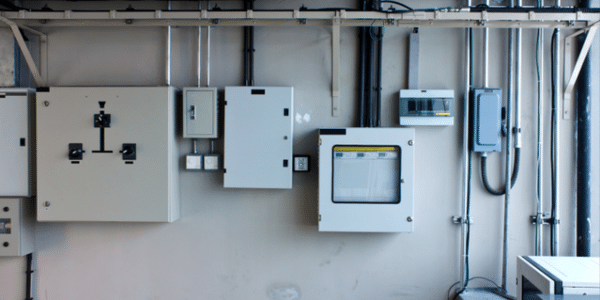How Electrical Fiberglass Boxes Contribute to Energy Efficiency in Buildings
6/19/20244 min read


Introduction to Electrical Fiberglass Boxes
Electrical fiberglass boxes are a vital component in modern building infrastructure, designed to house and protect electrical connections and wiring. These boxes are crafted from fiberglass, a composite material renowned for its exceptional properties. Fiberglass is composed of fine fibers of glass woven together and bonded with a resin. This composition results in a material that is both strong and lightweight, offering significant advantages over traditional materials like metal or plastic.
One of the key attributes of fiberglass is its strength, which provides robust protection for electrical systems against physical damage. Furthermore, fiberglass is lightweight, making it easier to handle and install, thereby reducing labor costs and installation time. In addition to being strong and lightweight, fiberglass is highly resistant to corrosion and temperature extremes. This resistance ensures that electrical fiberglass boxes maintain their integrity and performance even in harsh environmental conditions, thereby enhancing the longevity and reliability of electrical systems.
Energy efficiency in buildings is an increasingly important consideration in construction and architecture. Efficient energy use not only reduces operational costs but also minimizes the environmental impact of buildings. Electrical components, such as fiberglass boxes, play a crucial role in achieving energy efficiency. By providing secure and reliable housing for electrical connections, these boxes help prevent energy loss and ensure optimal performance of electrical systems.
Moreover, the insulating properties of fiberglass contribute to maintaining energy efficiency within buildings. Fiberglass does not conduct electricity, thus reducing the risk of short circuits and energy leakage. This insulation capability ensures that electrical systems operate safely and efficiently, further supporting the overall energy efficiency goals of modern buildings.
In summary, electrical fiberglass boxes offer numerous advantages over traditional materials, including strength, lightweight nature, and resistance to corrosion and temperature extremes. These attributes, combined with their role in enhancing energy efficiency, make fiberglass boxes an integral part of contemporary building infrastructure.
Energy Efficiency Benefits of Fiberglass Boxes
Electrical fiberglass boxes offer a range of energy efficiency benefits that make them an excellent choice for modern buildings. One of the primary advantages is their superior insulating properties. Fiberglass acts as an effective barrier against thermal transfer, which helps to reduce energy loss. This improved thermal management ensures that heating and cooling systems operate more efficiently, leading to lower energy consumption and reduced utility bills.
Another notable benefit is the lightweight nature of fiberglass. Compared to traditional materials like metal, fiberglass is much easier to handle and install. This attribute significantly reduces the labor and energy required for installation. Additionally, the ease of maintenance associated with fiberglass boxes further contributes to energy savings. Minimal maintenance needs mean less frequent interventions, which in turn lowers the overall energy expenditure associated with building upkeep.
The durability and longevity of fiberglass electrical boxes also play a crucial role in enhancing energy efficiency. Fiberglass is resistant to corrosion, weathering, and wear, which means that these boxes have a longer lifespan compared to other materials. This durability minimizes the need for replacements and repairs, conserving both resources and energy over the long term. By reducing the frequency of replacements, buildings can maintain consistent energy efficiency without the disruption and energy costs of frequent updates.
Case studies and real-world examples further illustrate the benefits of fiberglass electrical boxes. For instance, several commercial buildings have reported significant energy savings after switching to fiberglass boxes. These buildings have experienced lower heating and cooling costs, reduced installation times, and fewer maintenance issues. Such examples underscore the practical advantages of using fiberglass in electrical applications, reinforcing its role in promoting energy-efficient building practices.
In summary, the use of electrical fiberglass boxes contributes to energy efficiency through superior insulation, ease of installation and maintenance, and long-term durability. These benefits make fiberglass an optimal choice for enhancing the energy performance of modern buildings.
Implementing electrical fiberglass boxes in building projects requires a strategic approach to ensure energy efficiency and longevity. The first step is to accurately assess the specific needs of the building, including load capacity, environmental conditions, and electrical requirements. Selecting the right type of fiberglass box is crucial; for instance, boxes with higher load ratings are ideal for buildings with heavy electrical demands, while those with enhanced weather-resistant properties are better suited for harsh environmental conditions.
Adhering to best practices during installation is essential for optimizing the performance of fiberglass boxes. Properly sealing the boxes to prevent moisture ingress and using corrosion-resistant fasteners can significantly enhance their durability. Additionally, ensuring that the placement of these boxes allows for adequate ventilation can prevent overheating and further contribute to energy efficiency. During the installation, it's vital to follow manufacturer guidelines and industry standards, such as those outlined by the National Electrical Manufacturers Association (NEMA) and the International Electrotechnical Commission (IEC).
Maintenance is another critical aspect to consider. Regular inspections should be carried out to identify any signs of wear or damage that could compromise the electrical system's efficiency. Maintenance tasks might include checking for cracks, ensuring the integrity of seals, and verifying that all connections remain secure. Timely replacement of any damaged components can prevent energy losses and maintain the overall efficiency of the building's electrical network.
Staying informed about relevant regulations and industry standards is also important for successful implementation. Compliance with standards not only ensures safety but also enhances the reliability and performance of electrical systems. For example, adhering to the guidelines provided by the National Electrical Code (NEC) can help in achieving optimal energy efficiency and safety in building projects.
By following these best practices, architects, engineers, and builders can effectively leverage the benefits of electrical fiberglass boxes, ensuring that their projects not only meet energy efficiency goals but also maintain high standards of safety and durability.
